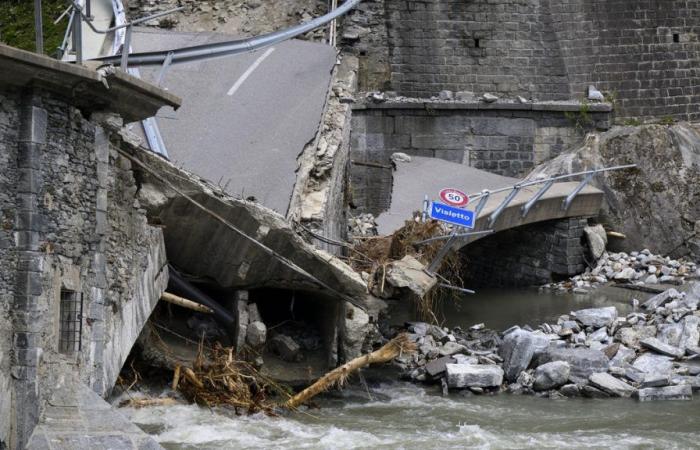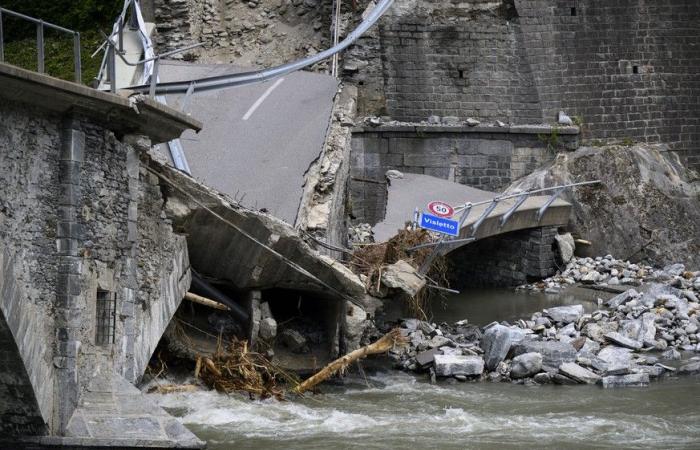The Visletto bridge in Val Maggia after bad weather, July 1, 2024.Keystone
It will take weeks or months before figures on the extent of the damage are available. A retrospective shows how this year’s storms differ from previous major events.
Ann-Kathrin Amstutz and Florence Vuichard / ch media
The collapsed Visletto bridge in Val Maggia, flooded districts in Chippis and Sierre, roads covered in scree in Saas Grund: the storms have left traces of their devastating passage in the Ticino and Valais valleys. They have caused several deaths and deprived many people of their homes or possessions. For the time being, the extent of the damage is still difficult to assess.
Christoph Hegg from the Swiss Federal Institute for Forest, Snow and Landscape Research ventures a first estimate:
“I assume that the damage will amount to several hundred million francs, but not billions as in 1987 or 2005.”
Christoph Hegg from the Swiss Federal Institute for Forest, Snow and Landscape Research
According to him, 2024 will certainly be a big year of bad weather, but not a year that will break records.
Insurance companies are not yet venturing into precise estimates. It is too early for that, say, for example, the reinsurer Swiss Re and the Swiss Insurance Association, which represents private insurers responsible for building insurance in seven cantons, including the two cantons most affected by the bad weather, Valais and Ticino.
Of the events cause significant damage
The WSL research institute produces an annual report on weather damage in Switzerland. The database dates back to 1972 and contains reports of floods, mudslides, landslides and rockfalls.
The 50-year overview shows that 2005 was the most expensive year for bad weather. At that time, floods, mudslides and landslides caused damage worth more than 3 billion francs throughout Switzerland. Almost one in three municipalities was affected in one way or another.
“At that time, the persistent rains and flooding were much more extensive than today, and so the damage was much greater.”
Christoph Hegg from the Swiss Federal Institute for Forest, Snow and Landscape Research
The northern slopes of the Alps were particularly affected, with rivers on the plateau such as the Aare, the Reuss and the Emme. On average, bad weather causes damage worth 311 million francs in our country each year. The median is 103 million francs, a relatively low figure. It is therefore mainly isolated large-scale events that cause high damage.
More than 90% of the damage is due to water and mudslides. “Thunderstorms” and “persistent rain” contribute roughly equally to the destruction. But the extent of the damage always depends on where the precipitation falls — for example, whether it hits a densely populated area and whether protective measures are already in place there.
Where the damage occurs is partly random, Hegg explains:
“There could be major flood damage anywhere in Switzerland”
Christoph Hegg from the Swiss Federal Institute for Forest, Snow and Landscape Research
In the mountains, due to the large differences in altitude, more energy is involved, which explains why the destruction is greater. On the other hand, on the Plateau, there are more inhabited areas where many buildings can be damaged.
The melt of ice causes flooding
The last year with significant damage was 2021, when damage amounted to CHF 450 million. However, the situation was different back then, explains Käthi Liechti, a research fellow at the Swiss Federal Institute for Forest, Snow and Landscape Research. Three years ago, Switzerland was hit by numerous storms. The Central Plateau and Ticino were particularly affected.
The weekend’s bad weather is, according to the expert, due to so-called orographic precipitation. This means that the moist air coming from the south was blocked by the mountains, resulting in almost stationary precipitation. In addition, it had already rained before and there is still an unusually high amount of snow for the season at altitude. The melting snow thus contributes to increased flows.
Why is it mainly water that generates such a great potential for destruction? “Often it is not the water itself, but the materials it carries that cause the destruction,” says Christoph Hegg. Liechti adds:
“You can’t stop water, you can only channel it”
Käthi Liechti, scientific collaborator at the Swiss Federal Institute for Forest, Snow and Landscape Research
Due to the Swiss topography, runoff water collects in valleys. When the soils are already saturated, additional precipitation runs off directly and quickly. In steep terrain, the water can then develop such force that it carries away large quantities of debris.
But it’s hard to say exactly why one stream overflows and not another. It depends partly on how long ago the last event happened and how much material has accumulated in the stream over time. “But there are also forces at work that you can only react to,” Liechti says.
It is therefore difficult to do prevention. It is always necessary to analyze the situation, if necessary, review the danger map in order to be able to prepare as well as possible.
THE damage increase every year
Reinsurer Swiss Re is also seeing an increase in insured weather-related losses worldwide. These are said to be increasing by 5 to 7 percent per year. Inflation, construction near waterways, population growth in cities in general and the resulting accumulation of values are the “main drivers” of this development.
Climate change is increasing the severity and frequency of storms. In 2023, insured losses are expected to exceed the $100 billion threshold for the fourth time in a row. This is mainly due to severe storms: in 2023, they caused insured losses of $64 billion – “a new record”, as Swiss Re notes. (aargauerzeitung.ch)
Translated and adapted by Noëline Flippe
The news in Switzerland is here
The floods that hit Grisons
1 / 14
The floods that hit Grisons
On Friday, June 21, the Moesa River burst its banks. The floods destroyed part of the A13 motorway and caused deadly landslides.
source: sda / alessandro crinari







